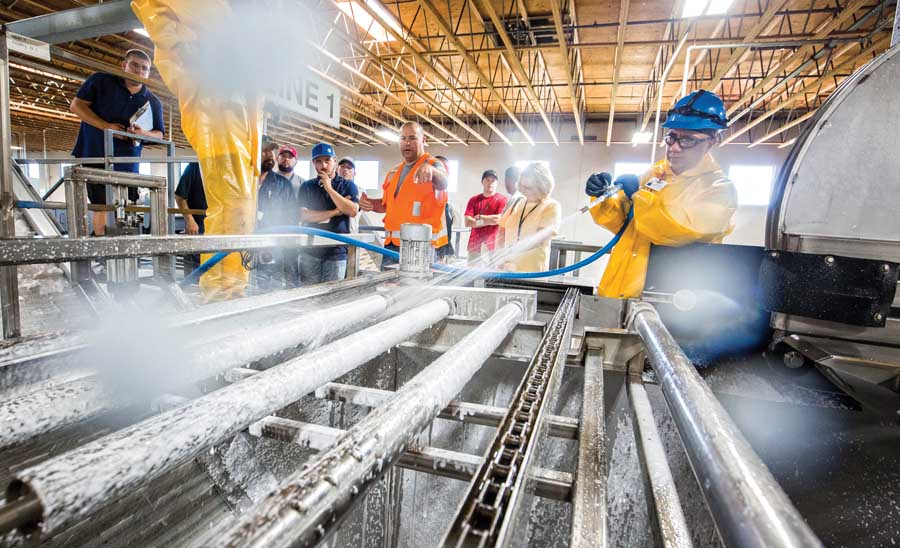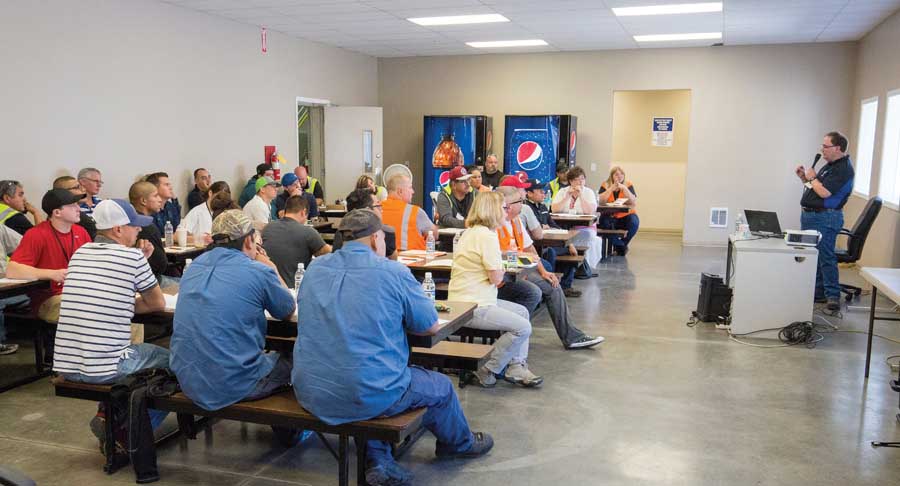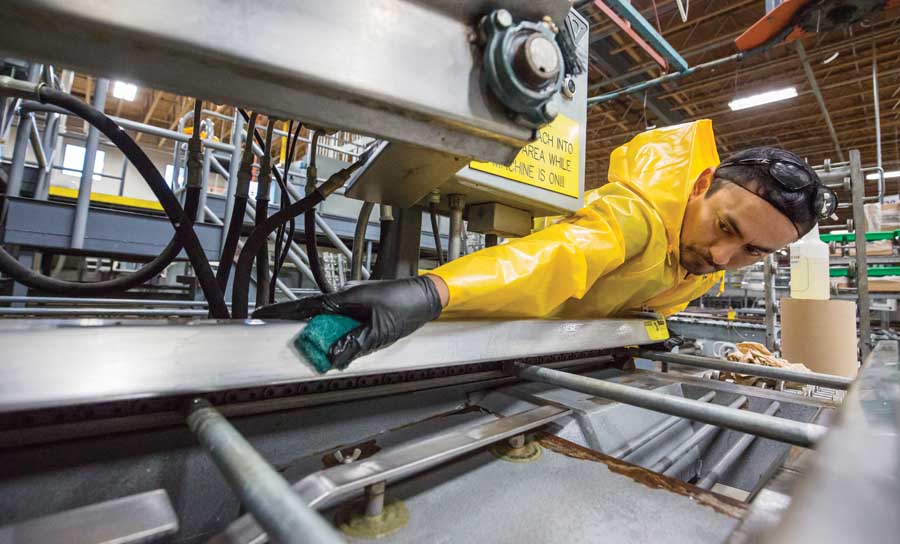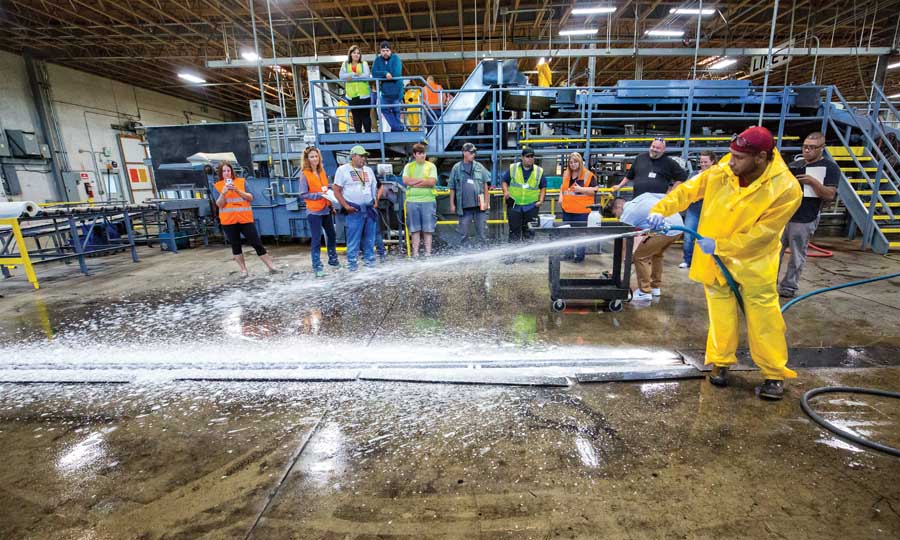
Julian Vasquez sprays chlorine foam as one of the steps operation crews employ to sanitize a cherry processing dump tank during a 2016 workshop offered by the Washington State Tree Fruit Association. (TJ Mullinax/Good Fruit Grower)
Sanitize gloves again after employee breaks if they were set on an unwashed table. Hang tools with bristles down in a closet when not in use.
Turn up water pressure high enough to move dirt, but not so high it splashes it around.
More than anything, though, approach all packing facility duties with a mindset of food safety, industry officials and sanitation supervisors say. Don’t just clean to mark a box on a checklist. Think like a pathogen.
Ask yourself, “If I was a germ, where would I be hiding,” said Laura Grunenfelder, technical issues manager for the Northwest Horticultural Council.
In the era of food safety pressure, the potential for contamination may seem endless, but industry officials and food safety supervisors have just as many tips and ideas for how to combat foodborne illnesses.
Washington’s tree fruit industry has been staging hands-on workshops inside warehouses to help packers learn best practices to keep pathogens such as Listeria monocytogenes (Listeria), Escherichia coli 0157:H7 (E. coli) or salmonella off their apples, cherries and pears.
Listeria is the pathogen of highest concern to the fruit industry because it’s the most serious; as many as 30 percent of Listeriosis cases result in death.
The bacteria lives and grows in temperatures ranging from freezing to 113 degrees Fahrenheit, at a wide array of pH levels and inside controlled-atmosphere rooms.
The Washington State Tree Fruit Association started the cleaning and sanitation workshops a year ago after a Listeria outbreak traced to caramel apples that were packed at Bidart Brothers in Bakersfield, California, killed seven people and hospitalized 34.
“An outbreak like that can cause significant losses for the whole industry,” said Jacqui Gordon, director of education and member services for the Tree Fruit Association.
If one shipper causes an outbreak, the whole industry gets a black eye. Sales drop for everyone.
In late July, the organization finished its third round of the workshops, which feature both classroom presentations and facility demonstrations in both Spanish and English.

Elis Owens, director of Birko Corp. technical services, speaks to workshop attendees
during a sanitation workshop offered by the Washington State Tree Fruit Association in Zillah, Washington. Owens recommends packing houses have a team of sanitation workers on each production shift to keep areas free of debris and push away standing water. “Their job during production is just to go out and just pick up stuff off the floor,” Owens said. (TJ Mullinax/Good Fruit Grower)
Already, they’ve attracted more than 250 people so far. The association spends about $800 on each workshop, which costs $45 per person. More are planned for next year.
The workshops primarily cover good manufacturing practices in the wake of outbreaks. However, they include brief updates about the Food Safety Modernization Act, or FSMA.
The Tree Fruit Association also holds educational events intended to help growers understand and implement FSMA requirements in their orchards, and future workshops specific to FSMA compliance are planned for warehouses.
Collaborators are the Northwest Horticultural Council and the Washington State Tree Fruit Research Commission, as well as the host packing companies.
A major message is that all packers should constantly improve their cleaning and sanitation techniques for the good of the entire industry.
“Food safety should not be a competitive advantage,” said Ines Hanrahan, a project manager for the Washington Tree Free Research Commission during the most recent workshop in Washington’s Yakima Valley.
Still, food safety is a tough conversation. Workshop organizers struggle to find packers willing to host the tours for fear they will be singled out for minor flaws.
“While there are certain things we cannot control, we can certainly improve as people how we react to everything, and we can improve what we do on a daily basis,” Hanrahan said.
Challenges

Alejandro Garcia hand scrubs the packing line conveyor system. (TJ Mullinax/Good Fruit Grower)
Not all packing facilities are designed with cleaning in mind.
For example, Elis Owens, director of technical services for Henderson, Colorado, sanitation company Birko, warned during the recent workshop against climbing on top of packing equipment to clean it to avoid contamination from boots that may have just been on an unsanitized floor. However, that may may be the only way to reach it.
Meanwhile, older lines often contain exposed electronics, wooden surfaces and hidden nooks and crannies that may be hard to clean.
Owens also has found packing line pipes, discarded after a renovation, coated with biofilm, a generic term to denote a sometimes invisible buildup of organic or material dirt that can harbor pathogens.
Packers should consider flushing pipes and flumes with a low-foaming cleaning solution with enough pressure to create a turbulent flow.
Another suggestion was placing sanitation workers on each production shift to keep areas free of debris and push away standing water.
“Their job during production is just to go out and just pick up stuff off the floor,” Owens said.
The workshop featured both classroom presentations from Hanrahan and Owens as well as live demonstrations by sanitation workers inside packing facilities.
At each packing house rotation, employees donned nylon protective “banana suits” to spray chlorine foam, scrub with green abrasive sponges and pressure rinse drains, dump tanks, belts, sorters and stem cutters on a cherry line.
One of the bigger lessons from the workshops: Seek dirt and grime in places where it’s not easily visible, such as inside hollow table legs.
At Washington Fruit and Produce, workers even clean the tops of ceiling beams, said Jeff Nordstrom, the company’s food safety administrator, leading a group during one of the facility rotations. Crews also take apart pieces of equipment to clean inside and around them.
He said food safety managers will have to adjust to the peculiarities of their own lines. For example, his crews rinse debris down into the bottom of the dump tank and hose it out a side hatch. Another facility turns on the elevator belt to bring it up where workers can more easily reach it.
Borton and Sons and other plants teach sanitation workers to swab for Adenosine Triphosphate, usually called ATP tests, which reveal proteins — not actual pathogens — after cleaning but before sanitizing each area.
“Sanitizers are not your end-all,” said Jeremy Leavitt food safety and compliance manager for Borton and Sons.
“It’s your insurance policy.” The company also tests periodically for specific pathogens — Listeria once a week and E. coli and salmonella once a month.
Borton and Sons gives incentives for cleanliness standards, another oft-repeated suggestion, granting a $25 gift card for each week with no positive ATP results, and offers pizza parties for teams that reach longer milestones. •
Cleaning and sanitizing tips

Andre Harrell evenly coats floor drains with chlorine foam before scrubbing debris off surfaces during the workshop. (TJ Mullinax/Good Fruit Grower)
Not all packing facilities, some of them decades old, were designed with cleaning in mind, but sanitation workshops hosted by the Washington State Tree Fruit Association offer numerous tips warehouse operators can follow to keep their facilities as clean as possible.
People
—Adopt a mindset of actively seeking out contamination.
—Create incentive programs, such as gift cards or pizza parties, for meeting cleanliness standards.
—Give sanitation employees strong, water-resistant flashlights.
—Hire roaming sanitation workers to remove standing water and pick up debris, such as cardboard scraps, during production shifts.
Water and chemicals
—Clean hidden areas and cavities, such as hollow legs or the undersides of surfaces.
—Lift out drain gates to clean both drains and gates more thoroughly.
—Calibrate water pressure to wash dirt but not spread it through excessive splashing.
—Use correct chemical concentrations. More does not always equal more effective.
—Restrict access to cleaning chemicals.
—Apply antimicrobial powders or foams to the floor at entry points.
Machinery
—Sanitize floor-scrubbing machines periodically.
—Clean forklifts periodically. Designate them for certain areas.
—Test rubber flaps often.
—Remove parts, such as belt cutter blade caps, for periodic cleaning.
—Take out wax brush rolls and soak them in cleaner. Use two sets to clean on a rotation.
—Use silicone rubber padding instead of foam.
—Line wooden orchard bins with a plastic bags to use them as soak tanks.
—Consider installing automatic belt cleaners that can be retrofitted to existing lines.
Work spaces
—Place floor mats only in areas for standing, not in transition traffic areas.
—Soak floor mats in solution while cleaning the floors beneath them.
—Remove or replace peeling grip tape from floors and stairs. It can harbor pests, as well as trip people.
Tools
—Designate cleaning tools, such as brushes and brooms, for certain areas. Color code them.
—Store brushes, brooms and mops head down to prevent dripping onto the handle.
—Use “captive” tools and personal protective gear that never leave the facility to prevent cross-contamination.
—Gloves protect surfaces and fruit, not the worker. Wash or replace gloves every time they touch something unrelated to the job, such as handrails or catwalks.
—Use disposable green scrubbers.
—Haul brooms and mops on a tool caddy with castors to prevent them from touching the floor when not in use.
—Whenever possible, clean with ladders and long-handled brushes to avoid climbing on equipment.
—Establish a schedule for disinfecting maintenance tools, such as wrenches and screwdrivers.
Building or upgrading a packing facility? Here are some design tips:
—Locate drains centrally for cleaning access.
—Use continuous smooth belts instead of segmented belts.
—Use stainless steel whenever possible and avoid soft metals, such as aluminum.
—Avoid wood.
—Keep welds smooth for easier cleaning.
—Set up equipment so sanitation workers can reach it with ladders instead of climbing.
—Consider a water treatment system to prevent rust and buildup of soap scum.
—Install good lighting.
—Provide adequate hand-washing facilities.
—Provide access to hot water for cleaning hoses.
—Drain condensation from coolers outdoors, not to the floor of the building.
—Build solid walkways over water or food contact areas to prevent debris from falling.
– by Ross Courtney






Leave A Comment